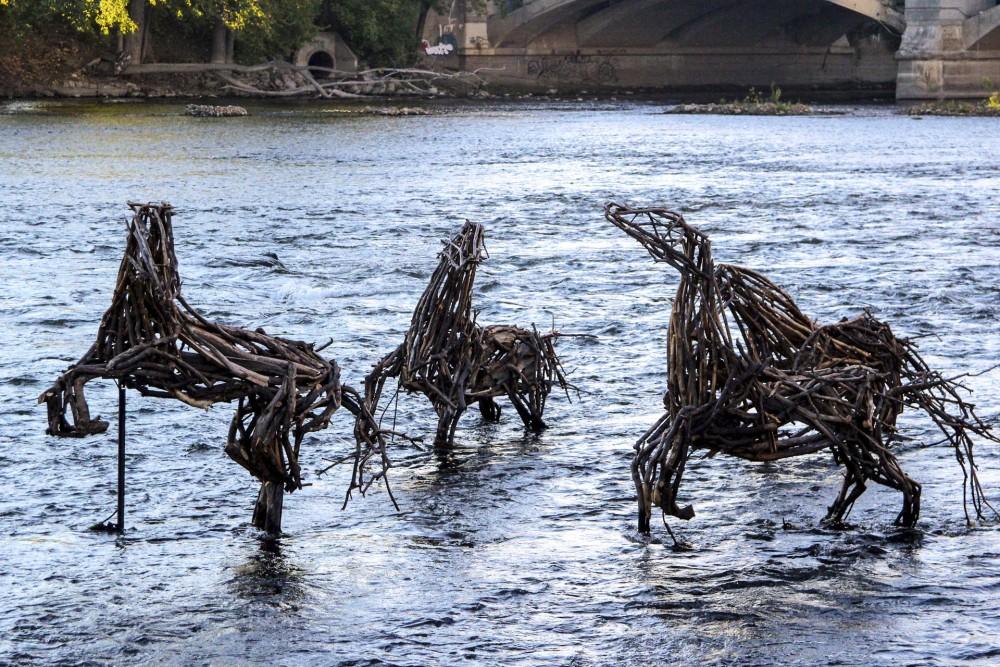Voting ends tonight to decide the public’s grand prize winner

GVL / Jessica Hollenbeck Grand Rapids Artprize 2012
Oct 4, 2012
The fate of 10 artists rests in the hands of Grand Rapids voters, who have until tonight at midnight to decide which 2012 ArtPrize entry will win the competition and the $200,000 grand prize.
ArtPrize founder Rick DeVos announced the Top 10 entries last Sunday, with not much surprise to many professional artists. Over the past four years, the most popular pieces in the contest have been ones that are in an easily accessible venue, and have a large-scale, time-consuming design.
Grand Valley State University printmaking and drawing professor Brett Colley said this year’s Top 10 cater to every aspect that impresses the average ArtPrize voter.
“As an artist and arts educator who favors conceptual considerations over technical prowess, the Top 10 are not things I would have chosen,” said Colley. “Well over half of the contenders are romantic depictions of nature/animals – humankind excepted. All are robust in scale, which ArtPrize voters seem to find objectively more impressive than smaller things.
Generally speaking, voters privilege particular technical skills, such as realistic painting, drawing, woodcarving and mosaic construction.”
Many of the finalists pull on the heartstrings of voters, such as “City Band” by Chris LaPorte, which Colley said has a nostalgic feel that could help it at least make the top three with voters.
LaPorte’s 24-foot wide and 14-foot high pencil drawing of his grandfather’s 1925 high school band has many of the aspects that GVSU sculpture professor Norwood Viviano said a winning piece needs. But he doesn’t think it will win the grand prize because it’s missing a crucial animal element. It doesn’t have any animal imagery, which won’t draw voters in as much, Viviano said.
One of his top contenders is “Elephants” by Adonna Khare.
“It’s the kind of work that everybody can relate to,” Viviano said. “In ArtPrize, it has all the qualities successful ArtPrize entries have.”
As a professional artist, current ArtPrize contestant, and former judge, Viviano said “Elephants” and “City Band” are the two Top 10 pieces deserving of the prize, but “Origami” by Kumi Yamashita does have some commendable qualities.
Those three pieces are all displayed at the Grand Rapids Art Museum. A possible coincidence, Colley said probably isn’t a coincidence at all.
“The three entries at the GRAM have a tremendous upper hand now, especially since voters aren’t required to see all 10 works,” Colley said. “I wouldn’t be at all surprised, only saddened if these entries wound up being ranked one, two, three. After all, it’s one-stop voting. People will crowd into the GRAM because they see the most work in one spot, for the least amount of waiting, jostling.”
There were two pieces that overlapped with the public’s Top 10 list and a juror’s short list: “Song of Lift,” by Martijn van Wagtendonk for 3D and “Stick-to-it-ive-ness: Unwavering pertinacity; perseverance” by Richard Morse for the use of an urban space.
Viviano was surprised Morse’s wood and metal horse sculptures placed in the Grand River between Fulton and Pearl streets were on the Urban Space short list. As a former judge, he understands the challenge of picking a favorite piece out of more than 1,500 entries, but he said there were several pieces that used urban space in a much more intriguing way.
In the past, Grand River entries have faired well amongst audiences, such as “Nessie” from ArtPrize 2009, but Viviano said the artwork is not worthy of the first place prize.
Colley doesn’t think any one work is deserving of such a large monetary prize.
“I don’t think any art contest should be awarding $200,000 to any one individual or entry, while so many others go unrecognized, or more importantly, un-subsidized,” Colley said. “On average, it costs each artist thousands of dollars to compete in ArtPrize – paying for studio space, materials, framing, crating, shipping, installation, lodging, eating, de-installation, entry fee, etc. – and more than 1,400 artists will return home with less money than they had in August.”
“Song of Lift” is Colley’s most likely choice for the grand prize because of its unique specialties and the obvious expenses van Wagtendonk spent to create the installation at the Urban Institute for Contemporary Art.
The public recognizes the Top 10 entries as pieces that are hard to make, and time-consuming that they can appreciate because of the skill-base needed to produce something of such a large scale, Viviano said. He saw a lot of talent this year at ArtPrize, and said there is artistic qualities in all of the Top 10 entries.
There is a lot of prize money riding on the one vote each voter gets to place by tonight, but whichever piece wins, Colley wants to remind artists that “’winning’ a contest like ArtPrize is no true measure of the quality of one’s artwork.” And even if a favorite isn’t recognized, it doesn’t mean that the entry is less artistic, it just didn’t favor as well with the ArtPrize audience.






















